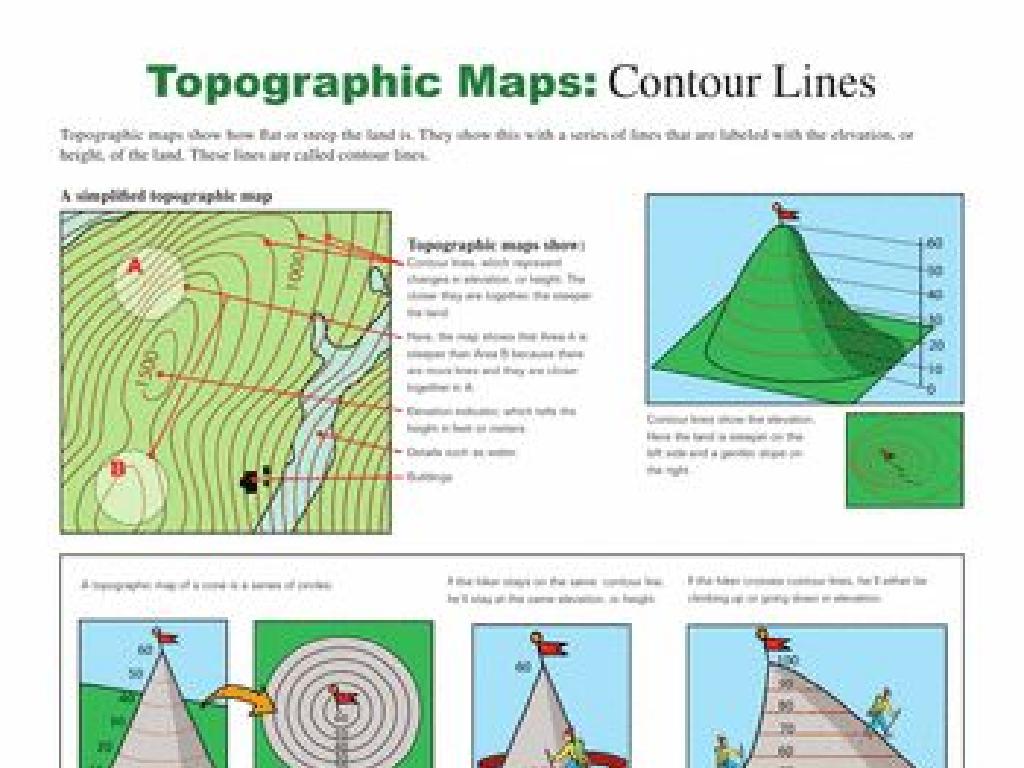Measure Angles With A Protractor
Subject: Math
Grade: Fourth grade
Topic: Angle Measurement
Please LOG IN to download the presentation. Access is available to registered users only.
View More Content
Introduction to Angles
– What are angles?
– Angles are formed by two rays meeting at a point.
– Angles in daily life
– Doorways, slices of pizza, clock hands show angles.
– Understanding angles
– We measure angles in degrees with a protractor.
– Examples of angles
– Example: Corner of a book is often a right angle.
|
Begin the lesson by explaining that angles are a fundamental concept in geometry, formed when two lines or rays meet at a single point. Illustrate the presence of angles in everyday life, such as the corners of rooms, slices of pizza, or the hands of a clock to make the concept relatable. Use visual aids to show different types of angles and their measurements. Demonstrate how to use a protractor to measure angles, starting with familiar objects like a book’s corner as a right angle. Encourage students to find and measure angles in the classroom for a hands-on understanding.
Types of Angles
– Acute Angles: Less than 90 degrees
– Example: The angle of a sharp pencil tip
– Right Angles: Exactly 90 degrees
– Example: The corner of a square or the hands of a clock at 3 o’clock
– Obtuse Angles: More than 90 degrees
– Example: The angle of a slice of pizza
– Straight Angles: Exactly 180 degrees
– Example: A straight line or the edge of a ruler
|
This slide introduces students to the basic types of angles they will encounter and measure. Acute angles are sharp and less than 90 degrees, often seen in everyday objects like a sharp pencil tip. Right angles are common in various forms, such as the corners of a square or when the clock hands show 3 o’clock. Obtuse angles are wider, like the angle of a slice of pizza. Straight angles are seen in straight lines or edges like a ruler. Encourage students to find these angles in the classroom for a better understanding. The next step will be to use a protractor to measure these angles accurately.
Getting to Know Your Protractor
– What is a protractor?
– A tool for measuring angles in degrees.
– Discover protractor parts
– Learn about the base, curved edge, and center hole.
– Handling a protractor safely
– Hold it carefully by the base, avoid touching the curved edge.
– Practice makes perfect
|
Introduce the protractor as a mathematical tool used to measure angles, ensuring students understand its purpose. Explain the different parts of a protractor, including the base for stability, the curved edge marked with degrees, and the center hole for precision. Emphasize the importance of handling a protractor with care to maintain its accuracy and avoid potential injury from its pointed edge. Encourage students to practice placing and reading a protractor on paper angles to gain confidence in using this tool effectively. Provide clear instructions and supervise as they handle the protractors for the first time.
Measuring Angles with a Protractor
– Place protractor on the angle
– Center the hole of the protractor on the angle’s vertex
– Align protractor’s base line
– Ensure the base line matches one side of the angle
– Read the correct scale
– Use the inner or outer scale depending on the angle direction
– Determine the angle measure
– Point where the second side of the angle meets the scale is the measure
|
This slide is designed to guide fourth-grade students through the process of measuring angles using a protractor. Start by placing the protractor’s center hole directly on the angle’s vertex. Align the base line of the protractor with one side of the angle. Teach students to determine which scale to use: the inner scale for angles opening to the right (acute angles) and the outer scale for angles opening to the left (obtuse angles). Finally, show them how to read the scale where the second side of the angle intersects to find the angle’s measurement. Encourage students to practice with different angles and to verify their measurements with a partner for accuracy.
Measuring Angles with a Protractor
– How to measure an acute angle
– Place the protractor’s center on the angle’s vertex, line up the baseline, and read the measurement.
– How to measure an obtuse angle
– Similar to acute angles, but the measurement will be greater than 90 degrees.
– The need for precise measurements
– Practice makes perfect
– Use different angles for practice and check precision.
|
This slide aims to teach students the correct method to measure angles using a protractor. Start by demonstrating how to measure an acute angle, ensuring that students understand the placement of the protractor and how to read the scale. Follow with measuring an obtuse angle, emphasizing that the only difference is in the range of the angle’s measurement. Highlight the importance of precision when measuring and recording angles, as small errors can lead to incorrect results. Encourage students to practice with a variety of angles to build their confidence and accuracy. Provide several examples for students to work on individually or in groups, and discuss common mistakes to watch out for.
Practice Time: Let’s Measure Angles!
– Class Activity: Angle Hunt
– Measure angles with a protractor
– Find objects with angles and measure
– Record your angle measurements
– Write down each angle’s measurement
– Share findings with the class
– Discuss how you got your measurements
|
This slide introduces a hands-on class activity where students will search for objects around the classroom that have angles. They will use protractors to measure these angles accurately. Encourage students to record their findings in their notebooks. After the activity, students will present their measurements to the class, explaining how they used the protractor and what they learned about angle measurement. Possible activities: measuring corners of books, angles of opened doors, or angles in various classroom shapes like desks. This will help students apply their knowledge of using a protractor in a fun and interactive way.
Class Activity: Create Your Own Angle Art!
– Use a protractor to draw angles
– Create an artistic design with angles
– Combine lines at different angles to make a picture or pattern
– Measure each angle accurately
– Check your work by measuring angles with a protractor
– Present your angle art to the class
– Explain what types of angles you used and how you created your design
|
This activity is designed to give students a hands-on experience with measuring angles using a protractor. Students will apply their knowledge creatively by incorporating various angles into an art project. Encourage them to explore different types of angles, such as acute, obtuse, and right angles, in their designs. Provide a variety of protractors and art supplies. Possible activities include creating a geometric animal, a city skyline, or a flower garden using different angles. After completion, students will present their artwork to the class, explaining the angles they used and how they measured them. This will reinforce their understanding and ability to communicate mathematical concepts.
Wrapping Up: Angles and Protractors
– Review of angle measurement
– Significance of learning angles
– Understanding angles is key in geometry and everyday life.
– Homework: Angle hunt at home
– Use a protractor to find and measure angles around your house.
– Share findings next class
– Be ready to discuss the angles you measured in our next session.
|
As we conclude today’s lesson, it’s important to recap the concept of angle measurement and its practical applications. Emphasize to the students how angles are everywhere, from the corners of their books to the tilt of a ladder. For homework, students should find various objects at home that form angles and measure them using a protractor. Encourage them to write down their measurements and be prepared to share their findings in the next class. This activity will reinforce their understanding and help them see the relevance of angles in their daily lives. Provide guidance on how to use a protractor correctly and remind them to handle it with care.






